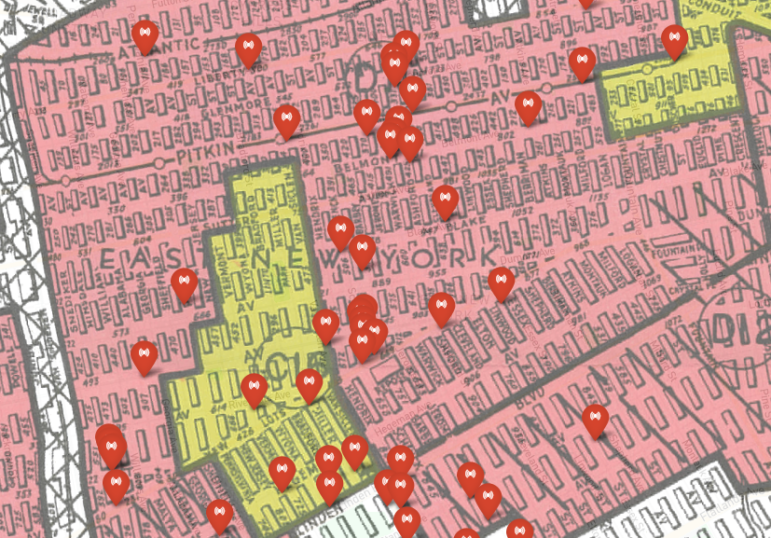
ENY Oral History Project
The project links audio clips to the sites each contributor discusses.
There’s the boilerplate story of what happened in East New York in the middle of the 20th Century—that families of color moved in, the neighborhood deteriorated, and whites fled. Then there’s what Carlos Bristol recalls.
“One of the things that was really interesting about this area was that Whites and Blacks oftentimes played together. I wasn’t aware of any racism—even though it existed—I wasn’t aware because everything going on was just natural to us,” he recalls. But the togetherness had limits. “Interestingly enough … there were some White, Caucasian friends I had but I never was inside their house. You just understood you’re not going to go in their house. They could came to my house. But we never went into their house. Maybe their parents weren’t as accepting as we were of each other.”
After its 2016 rezoning, East New York faces new changes. That makes it a good time to listen to Bristol’s voice and those of the 18 other people interviewed so far by Sarita Daftary-Steel’s East New York Oral History Project.
They’re folks like Anita Faulding was born in the Bronx in 1950 to parents who were leftist Jews, who moved to Linden Houses in 1957 and taught pre-school and elementary school in East New York until 2013, or Conrad Piggott, the product of African, German Jewish, and Taino ancestors, whose family lived in Boulevard Houses from 1955 to 1995 and now lives in Ocean Hill.
History often depicts as cohesive waves the social changes that, up close and in real time, look like individual drips and drops. Like what Isaiah Montgomery saw shortly after he and his family moved from Bedford-Stuyvesant to East New York in 1963, becoming—he says—only the third Black family in their section of the neighborhood.
“When I turned around and realized what had happened, I realized that the people—the Jewish people and the Italians—they were gone. I always figured that, we were moving in, they wanted to move out. I honestly … I really don’t think that these people got together and had a meeting and said, ‘Look, we’ve got to get out of here.’ I don’t think that happened. I just think, as individuals, they saw what they considered the neighborhood going down because of the Blacks and Hispanics moving into it and they wanted to move to a neighborhood of their own kind.”
Montgomery doesn’t dispute the idea that racial prejudice was behind the move. He just doesn’t think it was a coordinated act by Whites. Whatever the nature of the shift, the impact was quick, he says. “The stores up here left. And you knew it was bad. Everything was gone.”
Daftary-Steel began working in East New York in 2003, spending 10 years as a staff member of United Community Centers. There she began to hear people’s stories and recognizing the much fuller history they provide than most New Yorkers are taught.
“I would say that, as is often the case with oral history, viewing the history through people’s stories complicates the dominant narrative and often contradicts it,” she tells City Limits. One clear lesson, she says: “We did not arrive at the level of segregation we have in this city (or this country) through personal choice—not alone or even primarily. The fact that people repeatedly described to me neighbors of different races getting along quite well (and in some cases living somewhat separate but not antagonistic lives) seems to underscore the importance of policies that encouraged segregation.”
There is a larger truth there, Daftary-Steel says. Neighborhood change is less organic than we often depict it. It’s the result of policies that shape the context in which people’s individual choices—some of theme considerably constrained—play out.
Check out the project here.









3 thoughts on “UrbaNerd: East New York Tells its Own Story”
I spent some early years on Williams street, I attended P.S. 174. I remember some conflicts with the Black kids, but they were “Just Kids” to me and my cousins who were also the same age. A group of my Puerto Rican family moved to East New York from the west village, where they lived after coming from P.R. My family moved to Spanish Harlem in 1964. My friends and I traveled through the Back Yards, over wooden fences and alleys.
Thank you for the interesting story. I have only one question. How much of a role did upward mobility play in the relocation of the changing population in ENY?
In my families case it was the reason we left we the community in 1967 for suburban Huntington Long Island. I am a baby boomer whose family planned to move to the suburbs from East New York for at least 4 years before then. I remember the move coinciding with the rapid change of the racial makeup of the area in the 1960’s. However, the move would have occurred anyway. My father’s job relocated out in the suburbs, my mother wanted to teach in a suburban district, and my parents wanted a suburban lifestyle and more room to raise a larger family. I grew up in the projects South of Linden Boulevard which were primarily but not exclusively Jewish and Italian at the time. (early 1960’s) — and I DID have black friends over to visit on occasion btw. Although racism was clearly a reason for the change of neighborhood population for many, it was not for us and many of our friends and relatives who lived there.